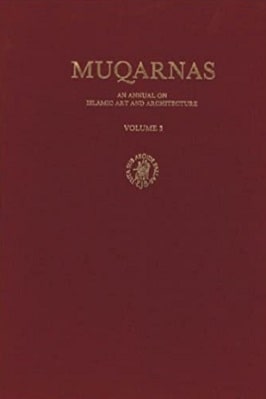
| An Annual On The Visual Culture Of The Islamic World |
| Oleg Grabar |
| 161 |
| |
| PDF Direct Download Link |
| Click for Hard Copy from Amazon |
An Annual on the Visual Culture of the Islamic World – Oleg Grabar – Muqarnas _ An Annual on Islamic Art and Architecture (Muqarnas)-E. J. Brill (1985)
AN ANNUAL ON THE VISUAL CULTURE OF THE ISLAMIC WORLD
The origin of Fatimid art
The Fatimid caliphs who ruled Egypt from 969 to 1171 are justly famed for their generous patronage of architecture and the arts and for their lavish ceremonies.
Almost immediately after they moved from North Africa, where they had ruled for half a century, to Egypt, where they founded their new capital of alQahira, men and women of the Fatimid court began to finance major buildings.
The arts of Egypt, most notably textiles and ceramics, flourished. While something of their character was anticipated in the artistic production of Tulunid Egypt, nothing known from that period quite prepares us for the splendid creativity that drew upon the traditions not only of Egypt but also of the entire medieval Mediterranean world.
What inspired this sudden efflorescence? Was it essentially an Egyptian or a dynastic development?
Is it attributable to general economic prosperity or solely to dynastic patronage?
To what extent do its sources lie in North Africa? Virtually everyone who has studied the art of the Fatimids has asked these questions, but the extremely fragmentary evidence for Fatimid patronage–the remnants of a few buildings, some textiles and coins, and an ivory box-before their move to Egypt makes their answers difficult to find.
Nevertheless the evidence for a coherent explanation can be extracted, if not from these few artistic remains, then from the texts that provide accounts of the dynasty’s early years.’
The foundation of the Fatimid caliphate in the early tenth century in what is now Tunisia was the result of a fortuitous convergence of events in Syria and North Africa.
From Salamiyya in Syria, a man claiming descent from the Prophet Muhammad through his daughter Fatima and his son-in-law ‘Ali ibn Abu Talib directed a vast but secret organization to convince the world that he was the sole legitimate heir to the Prophet.
His first victory came in North Africa, where the Aghlabid amirate was maintaining tenuous control for the Abbasids over a rebellious, largely Berber population.
Ten years of propagandizing and military ventures transformed the dream of a Fatimid state into a reality:
on 29 Rabi II 297 (26 January 910) one ‘Ubayd Allah assumed the protocolary title amir almu’minin (“Commander of the Believers”) and the regnal name of al-mahdi (“the Right Guide”) and, accompanied by his son and his chief missionary, rode into Raqqada, the Aghlabid capital, where he assumed his role as the just ruler on earth.?
Barely sixty years later, after decades of conflict and slow consolidation of power, ‘Ubayd Allah’s great-grandson, al-Mu’izz liDin Allah, rode triumphantly through Fustat, the capital of Egypt, and established his dynastic seat there on 7 Ramadan 362 (21 June 972).
The differences between ‘Ubayd Allah’s occupation of the Aghlabid capital in North Africa and his greatgrandson’s triumphal procession into the capital in Egypt are startling. ‘Ubayd Allah simply rode into town accompanied by his chief missionary and his son;
al-Mu’izz was the center of an elaborate theatrical spectacle mounted and performed under the direction of his general, Jawhar.
Met at the western desert by all the notables of Egypt, the ruler paraded through Giza, across the Nile by bridge, and through Fustat to alQahira, where Jawhar had prepared a magnificent palace for him in which he held court.3
The precision and elaborateness of the procession indicate not only the importance attributed to it, but also the Fatimids’ ability to mount such a spectacle.
The founding of a new capital in Egypt and its inaugural festivities also testify to an extraordinary development in the dynasty’s awareness of the power of visual symbols, such as constructions, coins, banners, and parades, for maintaining the caliph’s personal and dynastic prestige and for manipulating popular support.
Although such forms and practices became a hallmark of the Fatimids, they were certainly not unique to them but already commonly practiced among contemporary rulers, both Muslim and Christian.
Tracing the development of their use through the period of Fatimid rule in North Africa does, however,
To read more about the An Annual On The Visual Culture Of The Islamic World book Click the download button below to get it for free
or
Report broken link
Support this Website
for websites